Food Service Management
VerifiedAdded on 2023/01/05
|13
|4098
|25
AI Summary
Contribute Materials
Your contribution can guide someone’s learning journey. Share your
documents today.
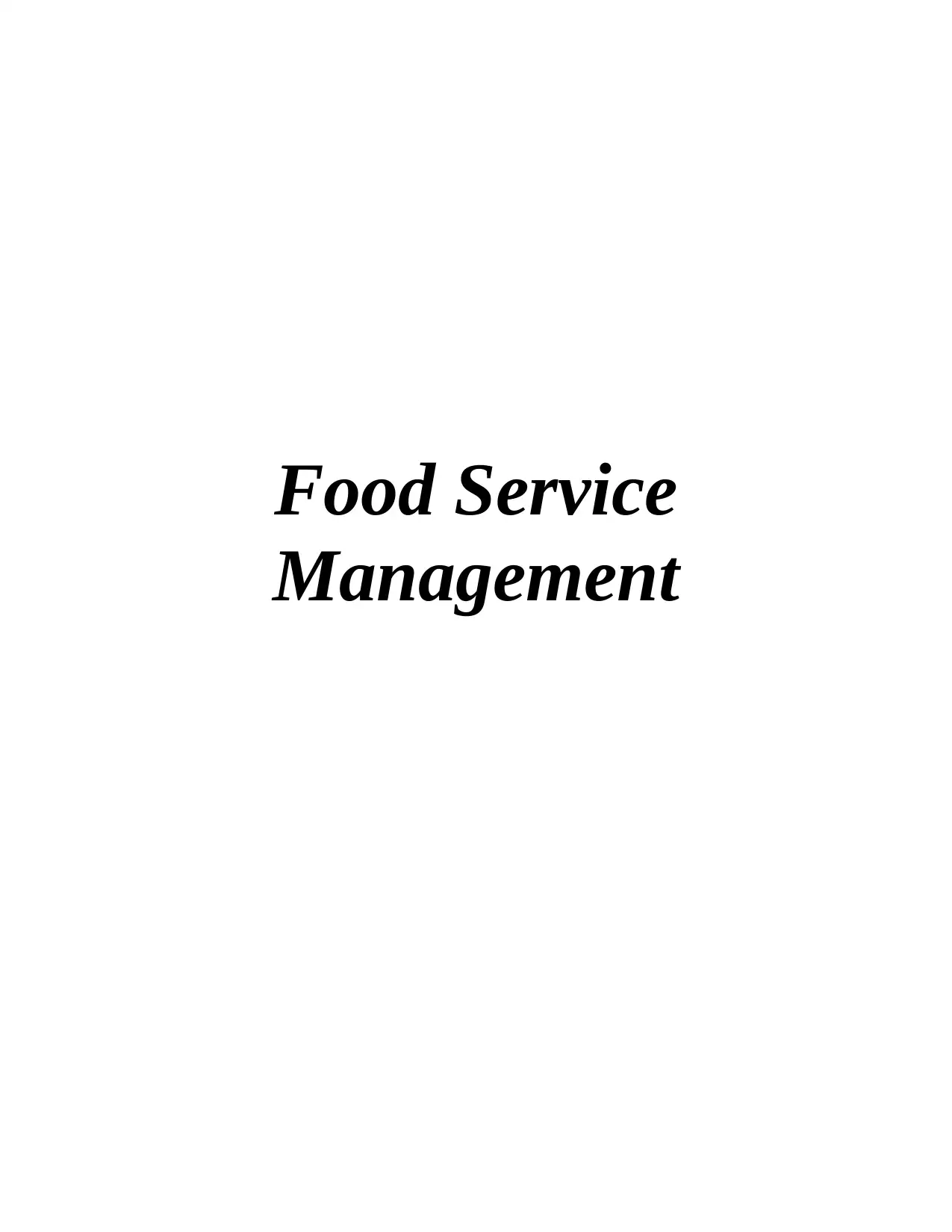
Food Service
Management
Management
Secure Best Marks with AI Grader
Need help grading? Try our AI Grader for instant feedback on your assignments.
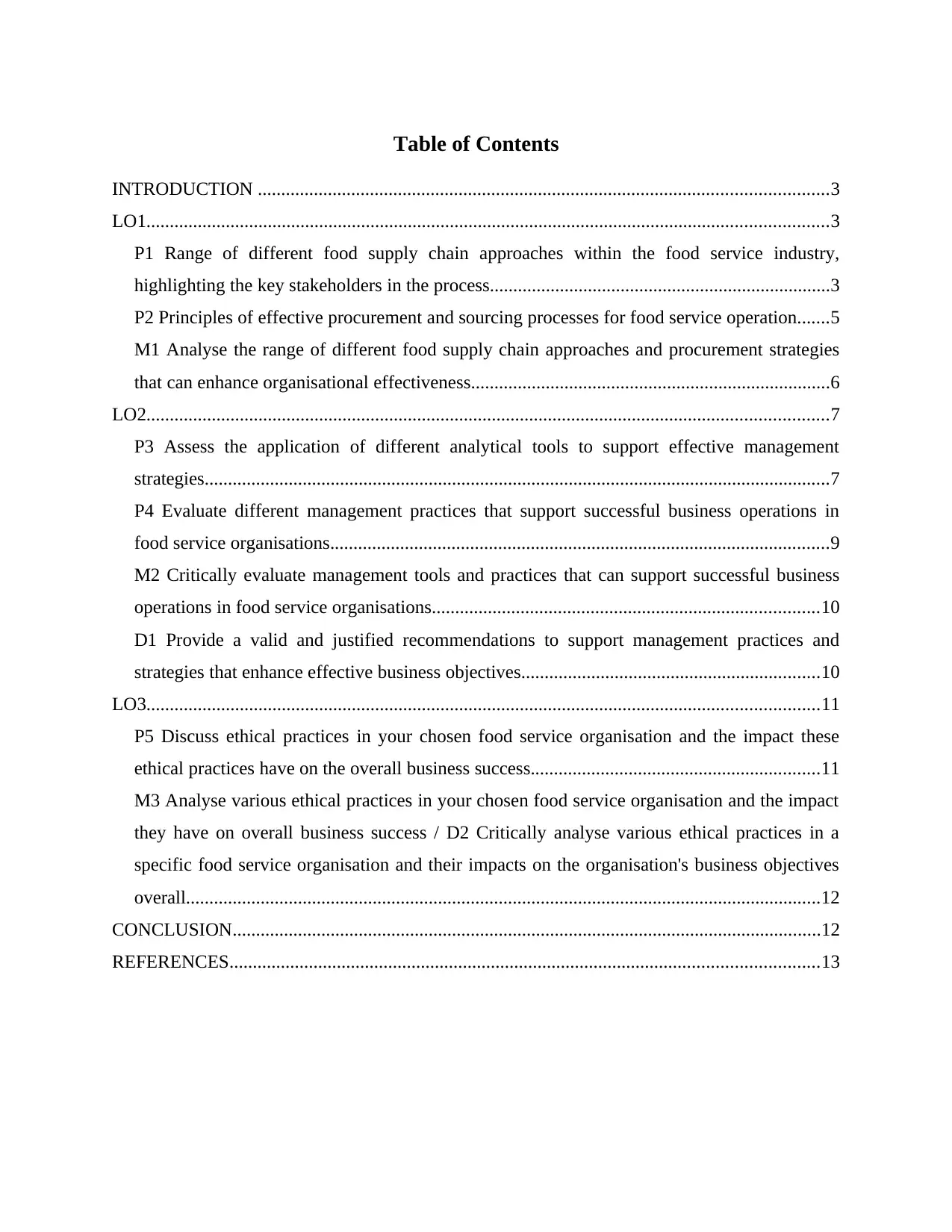
Table of Contents
INTRODUCTION ..........................................................................................................................3
LO1..................................................................................................................................................3
P1 Range of different food supply chain approaches within the food service industry,
highlighting the key stakeholders in the process.........................................................................3
P2 Principles of effective procurement and sourcing processes for food service operation.......5
M1 Analyse the range of different food supply chain approaches and procurement strategies
that can enhance organisational effectiveness.............................................................................6
LO2..................................................................................................................................................7
P3 Assess the application of different analytical tools to support effective management
strategies......................................................................................................................................7
P4 Evaluate different management practices that support successful business operations in
food service organisations...........................................................................................................9
M2 Critically evaluate management tools and practices that can support successful business
operations in food service organisations...................................................................................10
D1 Provide a valid and justified recommendations to support management practices and
strategies that enhance effective business objectives................................................................10
LO3................................................................................................................................................11
P5 Discuss ethical practices in your chosen food service organisation and the impact these
ethical practices have on the overall business success..............................................................11
M3 Analyse various ethical practices in your chosen food service organisation and the impact
they have on overall business success / D2 Critically analyse various ethical practices in a
specific food service organisation and their impacts on the organisation's business objectives
overall........................................................................................................................................12
CONCLUSION..............................................................................................................................12
REFERENCES..............................................................................................................................13
INTRODUCTION ..........................................................................................................................3
LO1..................................................................................................................................................3
P1 Range of different food supply chain approaches within the food service industry,
highlighting the key stakeholders in the process.........................................................................3
P2 Principles of effective procurement and sourcing processes for food service operation.......5
M1 Analyse the range of different food supply chain approaches and procurement strategies
that can enhance organisational effectiveness.............................................................................6
LO2..................................................................................................................................................7
P3 Assess the application of different analytical tools to support effective management
strategies......................................................................................................................................7
P4 Evaluate different management practices that support successful business operations in
food service organisations...........................................................................................................9
M2 Critically evaluate management tools and practices that can support successful business
operations in food service organisations...................................................................................10
D1 Provide a valid and justified recommendations to support management practices and
strategies that enhance effective business objectives................................................................10
LO3................................................................................................................................................11
P5 Discuss ethical practices in your chosen food service organisation and the impact these
ethical practices have on the overall business success..............................................................11
M3 Analyse various ethical practices in your chosen food service organisation and the impact
they have on overall business success / D2 Critically analyse various ethical practices in a
specific food service organisation and their impacts on the organisation's business objectives
overall........................................................................................................................................12
CONCLUSION..............................................................................................................................12
REFERENCES..............................................................................................................................13

INTRODUCTION
Food Service facilities like diners, restaurants, coffee shops and cafes are active part of
food service sector of hospitality that is Food & Beverage (F&B). Food Service Management is a
critical task to perform which has number of tasks involved in the operations like, menu
planning, revenue management, property and interior management, marketing and customer
services (Bronson and Knezevic, 2016). Management of food service organisation needs number
of strategic approaches and tool irrespective of the status of the company that is either its is new
developing or have been already existing in the market. The report is constructed in relation with
Galvin at Window Restaurant & Bar a rooftop restaurant in London. Initially, the report includes
a discussion on supply chain approaches and their key stakeholders and discussing the effective
procurement and sourcing processes. Moreover, analytical tool of management for the restaurant
are suggested and some management practices which are essential for managers to conduct for
smooth functioning of the restaurant are evaluated. Furthermore, in the end some ethical aspects
of management with food service organisation are examined for knowing their impacts on the
success of the restaurant.
LO1
P1 Range of different food supply chain approaches within the food service industry,
highlighting the key stakeholders in the process.
Food Supply Chain is a system or a process that includes the steps which are taken for
bring the raw material into finished form on the table of the end user that is the guests of the food
service organisation. The food supply chain is recognised as “Farm to Fork” as well with
integration of all the activities that are essential for transforming the food stuff (Raw Material)
into customer ready product (Final Good) according to need and preferences of clients
(Homburg, Jozić and Kuehnl, 2017). The food supply chain process or system makes sure to
move food products systematically form the producers to the consumers. The “Farm to Fork”
system involves stages which are as follows:
Food Service facilities like diners, restaurants, coffee shops and cafes are active part of
food service sector of hospitality that is Food & Beverage (F&B). Food Service Management is a
critical task to perform which has number of tasks involved in the operations like, menu
planning, revenue management, property and interior management, marketing and customer
services (Bronson and Knezevic, 2016). Management of food service organisation needs number
of strategic approaches and tool irrespective of the status of the company that is either its is new
developing or have been already existing in the market. The report is constructed in relation with
Galvin at Window Restaurant & Bar a rooftop restaurant in London. Initially, the report includes
a discussion on supply chain approaches and their key stakeholders and discussing the effective
procurement and sourcing processes. Moreover, analytical tool of management for the restaurant
are suggested and some management practices which are essential for managers to conduct for
smooth functioning of the restaurant are evaluated. Furthermore, in the end some ethical aspects
of management with food service organisation are examined for knowing their impacts on the
success of the restaurant.
LO1
P1 Range of different food supply chain approaches within the food service industry,
highlighting the key stakeholders in the process.
Food Supply Chain is a system or a process that includes the steps which are taken for
bring the raw material into finished form on the table of the end user that is the guests of the food
service organisation. The food supply chain is recognised as “Farm to Fork” as well with
integration of all the activities that are essential for transforming the food stuff (Raw Material)
into customer ready product (Final Good) according to need and preferences of clients
(Homburg, Jozić and Kuehnl, 2017). The food supply chain process or system makes sure to
move food products systematically form the producers to the consumers. The “Farm to Fork”
system involves stages which are as follows:

Farmer – Processor – Transportation / Storage – Consumer
Food supply chain has number of approaches which can be adopted by restaurant and in
this case Galvin at Window Restaurant & Bar for making the most suitable quality of food and
beverage to the customers in relation to their preferences. There are mainly three types of supply
chain approaches that involves different stakeholders and determined by number of stakeholders
involved in the process. The three supply chains are follows: Direct Supply Chain- This is a small supply chain in which only three stakeholders are
involved the Supplier, a Central Company and a Buyer (Brown and et. al., 2018). In
context of food service organisation that is Galvin at Window Restaurant the stakeholders
who will be involved in it are the raw material providers form whom restaurant will buy
ingredients for the menu, the Galvin at Window Restaurant itself and the customers
visiting the restaurant. Extended Supply Chain- This is comparatively a larger supply chain then the above,
including Three Middle persons or Suppliers then the Company and then the End
Users (Irani and Sharif, 2016). In regard to Galvin at Window Restaurant, the suppliers
will be the farmer who is cultivating the raw material, the processor changing it into
usable form and the transporter, the company will be Galvin at Window Restaurant and
Food supply chain has number of approaches which can be adopted by restaurant and in
this case Galvin at Window Restaurant & Bar for making the most suitable quality of food and
beverage to the customers in relation to their preferences. There are mainly three types of supply
chain approaches that involves different stakeholders and determined by number of stakeholders
involved in the process. The three supply chains are follows: Direct Supply Chain- This is a small supply chain in which only three stakeholders are
involved the Supplier, a Central Company and a Buyer (Brown and et. al., 2018). In
context of food service organisation that is Galvin at Window Restaurant the stakeholders
who will be involved in it are the raw material providers form whom restaurant will buy
ingredients for the menu, the Galvin at Window Restaurant itself and the customers
visiting the restaurant. Extended Supply Chain- This is comparatively a larger supply chain then the above,
including Three Middle persons or Suppliers then the Company and then the End
Users (Irani and Sharif, 2016). In regard to Galvin at Window Restaurant, the suppliers
will be the farmer who is cultivating the raw material, the processor changing it into
usable form and the transporter, the company will be Galvin at Window Restaurant and
Secure Best Marks with AI Grader
Need help grading? Try our AI Grader for instant feedback on your assignments.
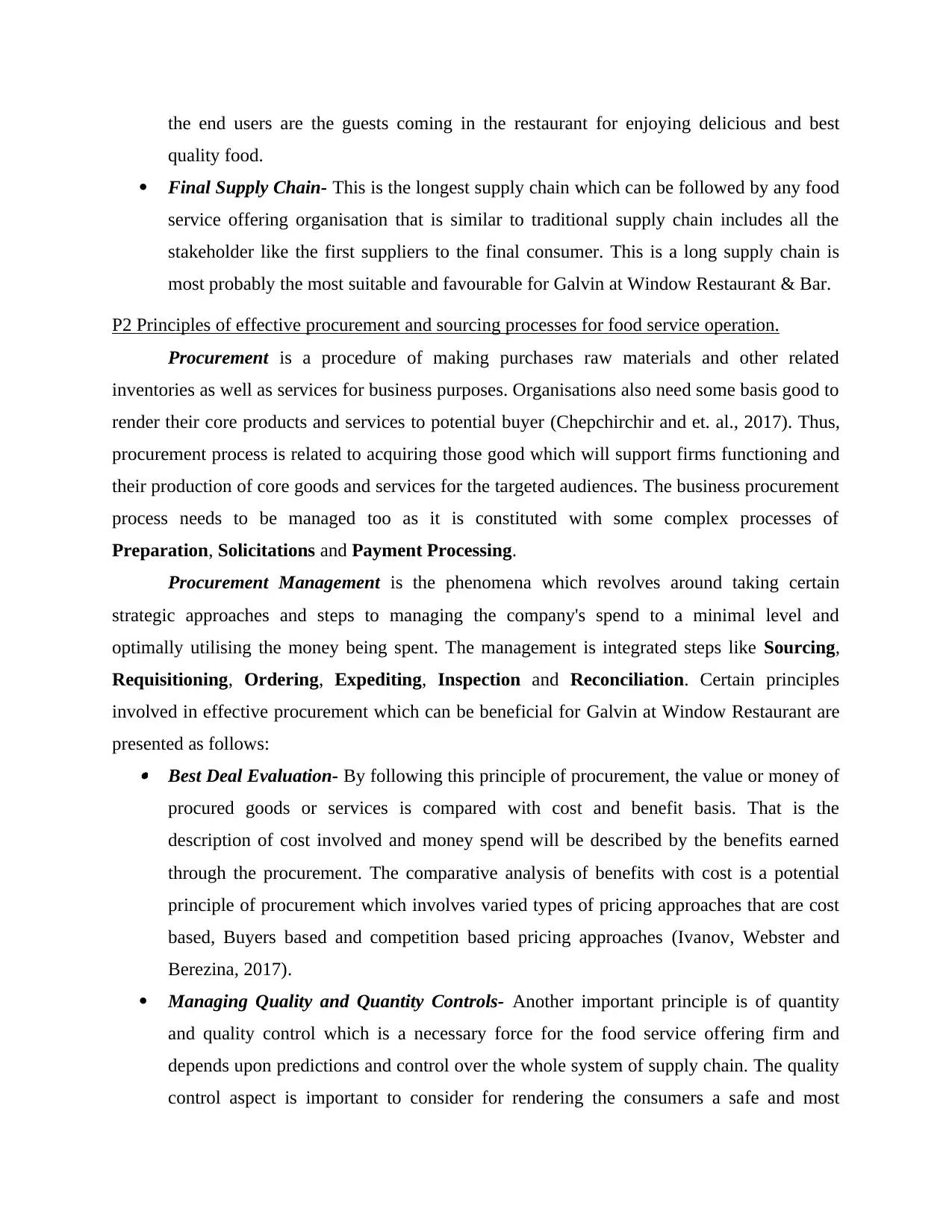
the end users are the guests coming in the restaurant for enjoying delicious and best
quality food.
Final Supply Chain- This is the longest supply chain which can be followed by any food
service offering organisation that is similar to traditional supply chain includes all the
stakeholder like the first suppliers to the final consumer. This is a long supply chain is
most probably the most suitable and favourable for Galvin at Window Restaurant & Bar.
P2 Principles of effective procurement and sourcing processes for food service operation.
Procurement is a procedure of making purchases raw materials and other related
inventories as well as services for business purposes. Organisations also need some basis good to
render their core products and services to potential buyer (Chepchirchir and et. al., 2017). Thus,
procurement process is related to acquiring those good which will support firms functioning and
their production of core goods and services for the targeted audiences. The business procurement
process needs to be managed too as it is constituted with some complex processes of
Preparation, Solicitations and Payment Processing.
Procurement Management is the phenomena which revolves around taking certain
strategic approaches and steps to managing the company's spend to a minimal level and
optimally utilising the money being spent. The management is integrated steps like Sourcing,
Requisitioning, Ordering, Expediting, Inspection and Reconciliation. Certain principles
involved in effective procurement which can be beneficial for Galvin at Window Restaurant are
presented as follows: Best Deal Evaluation- By following this principle of procurement, the value or money of
procured goods or services is compared with cost and benefit basis. That is the
description of cost involved and money spend will be described by the benefits earned
through the procurement. The comparative analysis of benefits with cost is a potential
principle of procurement which involves varied types of pricing approaches that are cost
based, Buyers based and competition based pricing approaches (Ivanov, Webster and
Berezina, 2017).
Managing Quality and Quantity Controls- Another important principle is of quantity
and quality control which is a necessary force for the food service offering firm and
depends upon predictions and control over the whole system of supply chain. The quality
control aspect is important to consider for rendering the consumers a safe and most
quality food.
Final Supply Chain- This is the longest supply chain which can be followed by any food
service offering organisation that is similar to traditional supply chain includes all the
stakeholder like the first suppliers to the final consumer. This is a long supply chain is
most probably the most suitable and favourable for Galvin at Window Restaurant & Bar.
P2 Principles of effective procurement and sourcing processes for food service operation.
Procurement is a procedure of making purchases raw materials and other related
inventories as well as services for business purposes. Organisations also need some basis good to
render their core products and services to potential buyer (Chepchirchir and et. al., 2017). Thus,
procurement process is related to acquiring those good which will support firms functioning and
their production of core goods and services for the targeted audiences. The business procurement
process needs to be managed too as it is constituted with some complex processes of
Preparation, Solicitations and Payment Processing.
Procurement Management is the phenomena which revolves around taking certain
strategic approaches and steps to managing the company's spend to a minimal level and
optimally utilising the money being spent. The management is integrated steps like Sourcing,
Requisitioning, Ordering, Expediting, Inspection and Reconciliation. Certain principles
involved in effective procurement which can be beneficial for Galvin at Window Restaurant are
presented as follows: Best Deal Evaluation- By following this principle of procurement, the value or money of
procured goods or services is compared with cost and benefit basis. That is the
description of cost involved and money spend will be described by the benefits earned
through the procurement. The comparative analysis of benefits with cost is a potential
principle of procurement which involves varied types of pricing approaches that are cost
based, Buyers based and competition based pricing approaches (Ivanov, Webster and
Berezina, 2017).
Managing Quality and Quantity Controls- Another important principle is of quantity
and quality control which is a necessary force for the food service offering firm and
depends upon predictions and control over the whole system of supply chain. The quality
control aspect is important to consider for rendering the consumers a safe and most

protected goods which are helpful in meeting their expectation criteria for consistency.
The principle involves aspects like Use of Supplier credibility, Carrying out random
checks and Use of Approved Supplier Lists.
Sourcing is one key step of procurement system of a food service management
organisation which is being practised or performed prior to make any purchases. The souring
process is simply related with locating and determining different resources from which the
company can collect and purchase raw materials for their final product to make sale to end user
and addressing their needs potentially. The concept is focused on finding the most suitable, lower
cost supplier for ingredients and inventories needed for the products and services. Some of its
principles that should be considered by the management of Galvin at Window Restaurant for
effective functioning are as follows: Traceability of product origins- This principle is related with an ability for searching out
the origin of food, ingredients and food resources. This will enable the company is
locating the best quality raw material supplier (Coyle and Fair, 2018).
Value for money- Another effective principle is of Value for money which is a
combination of cost, quality and sustainability for meeting organisations as well as
customers needs. The principle focus on keeping the spending economic, increasing
efficiency and meet objectives effectively with utmost potentials.
M1 Analyse the range of different food supply chain approaches and procurement strategies that
can enhance organisational effectiveness.
Food supply chain approaches are discussed in the above section and in regards to Galvin
at Window Restaurant the best and most suitable approach will be longer supply chain involving
number for suppliers which will keep the product quality high as several experts and their
expertise will be engaged in changing raw material into finished goods (Kirchhof and et. al.,
2016). The extended supply chain will enable the Galvin at Window Restaurant to make
appropriate procurement by using separate principles of best deal evaluation and most
significantly of quality and quantity management and control.
The principle involves aspects like Use of Supplier credibility, Carrying out random
checks and Use of Approved Supplier Lists.
Sourcing is one key step of procurement system of a food service management
organisation which is being practised or performed prior to make any purchases. The souring
process is simply related with locating and determining different resources from which the
company can collect and purchase raw materials for their final product to make sale to end user
and addressing their needs potentially. The concept is focused on finding the most suitable, lower
cost supplier for ingredients and inventories needed for the products and services. Some of its
principles that should be considered by the management of Galvin at Window Restaurant for
effective functioning are as follows: Traceability of product origins- This principle is related with an ability for searching out
the origin of food, ingredients and food resources. This will enable the company is
locating the best quality raw material supplier (Coyle and Fair, 2018).
Value for money- Another effective principle is of Value for money which is a
combination of cost, quality and sustainability for meeting organisations as well as
customers needs. The principle focus on keeping the spending economic, increasing
efficiency and meet objectives effectively with utmost potentials.
M1 Analyse the range of different food supply chain approaches and procurement strategies that
can enhance organisational effectiveness.
Food supply chain approaches are discussed in the above section and in regards to Galvin
at Window Restaurant the best and most suitable approach will be longer supply chain involving
number for suppliers which will keep the product quality high as several experts and their
expertise will be engaged in changing raw material into finished goods (Kirchhof and et. al.,
2016). The extended supply chain will enable the Galvin at Window Restaurant to make
appropriate procurement by using separate principles of best deal evaluation and most
significantly of quality and quantity management and control.
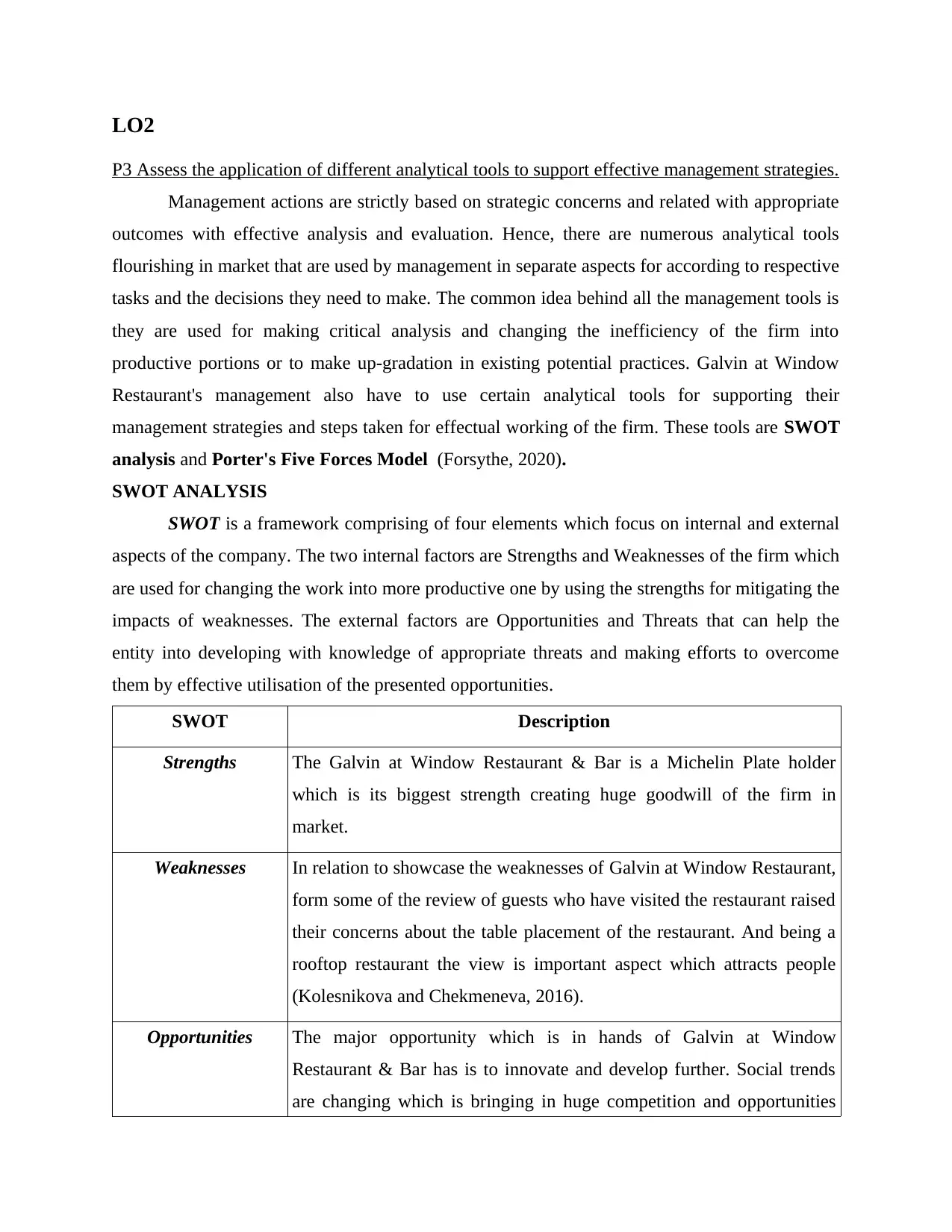
LO2
P3 Assess the application of different analytical tools to support effective management strategies.
Management actions are strictly based on strategic concerns and related with appropriate
outcomes with effective analysis and evaluation. Hence, there are numerous analytical tools
flourishing in market that are used by management in separate aspects for according to respective
tasks and the decisions they need to make. The common idea behind all the management tools is
they are used for making critical analysis and changing the inefficiency of the firm into
productive portions or to make up-gradation in existing potential practices. Galvin at Window
Restaurant's management also have to use certain analytical tools for supporting their
management strategies and steps taken for effectual working of the firm. These tools are SWOT
analysis and Porter's Five Forces Model (Forsythe, 2020).
SWOT ANALYSIS
SWOT is a framework comprising of four elements which focus on internal and external
aspects of the company. The two internal factors are Strengths and Weaknesses of the firm which
are used for changing the work into more productive one by using the strengths for mitigating the
impacts of weaknesses. The external factors are Opportunities and Threats that can help the
entity into developing with knowledge of appropriate threats and making efforts to overcome
them by effective utilisation of the presented opportunities.
SWOT Description
Strengths The Galvin at Window Restaurant & Bar is a Michelin Plate holder
which is its biggest strength creating huge goodwill of the firm in
market.
Weaknesses In relation to showcase the weaknesses of Galvin at Window Restaurant,
form some of the review of guests who have visited the restaurant raised
their concerns about the table placement of the restaurant. And being a
rooftop restaurant the view is important aspect which attracts people
(Kolesnikova and Chekmeneva, 2016).
Opportunities The major opportunity which is in hands of Galvin at Window
Restaurant & Bar has is to innovate and develop further. Social trends
are changing which is bringing in huge competition and opportunities
P3 Assess the application of different analytical tools to support effective management strategies.
Management actions are strictly based on strategic concerns and related with appropriate
outcomes with effective analysis and evaluation. Hence, there are numerous analytical tools
flourishing in market that are used by management in separate aspects for according to respective
tasks and the decisions they need to make. The common idea behind all the management tools is
they are used for making critical analysis and changing the inefficiency of the firm into
productive portions or to make up-gradation in existing potential practices. Galvin at Window
Restaurant's management also have to use certain analytical tools for supporting their
management strategies and steps taken for effectual working of the firm. These tools are SWOT
analysis and Porter's Five Forces Model (Forsythe, 2020).
SWOT ANALYSIS
SWOT is a framework comprising of four elements which focus on internal and external
aspects of the company. The two internal factors are Strengths and Weaknesses of the firm which
are used for changing the work into more productive one by using the strengths for mitigating the
impacts of weaknesses. The external factors are Opportunities and Threats that can help the
entity into developing with knowledge of appropriate threats and making efforts to overcome
them by effective utilisation of the presented opportunities.
SWOT Description
Strengths The Galvin at Window Restaurant & Bar is a Michelin Plate holder
which is its biggest strength creating huge goodwill of the firm in
market.
Weaknesses In relation to showcase the weaknesses of Galvin at Window Restaurant,
form some of the review of guests who have visited the restaurant raised
their concerns about the table placement of the restaurant. And being a
rooftop restaurant the view is important aspect which attracts people
(Kolesnikova and Chekmeneva, 2016).
Opportunities The major opportunity which is in hands of Galvin at Window
Restaurant & Bar has is to innovate and develop further. Social trends
are changing which is bringing in huge competition and opportunities
Paraphrase This Document
Need a fresh take? Get an instant paraphrase of this document with our AI Paraphraser
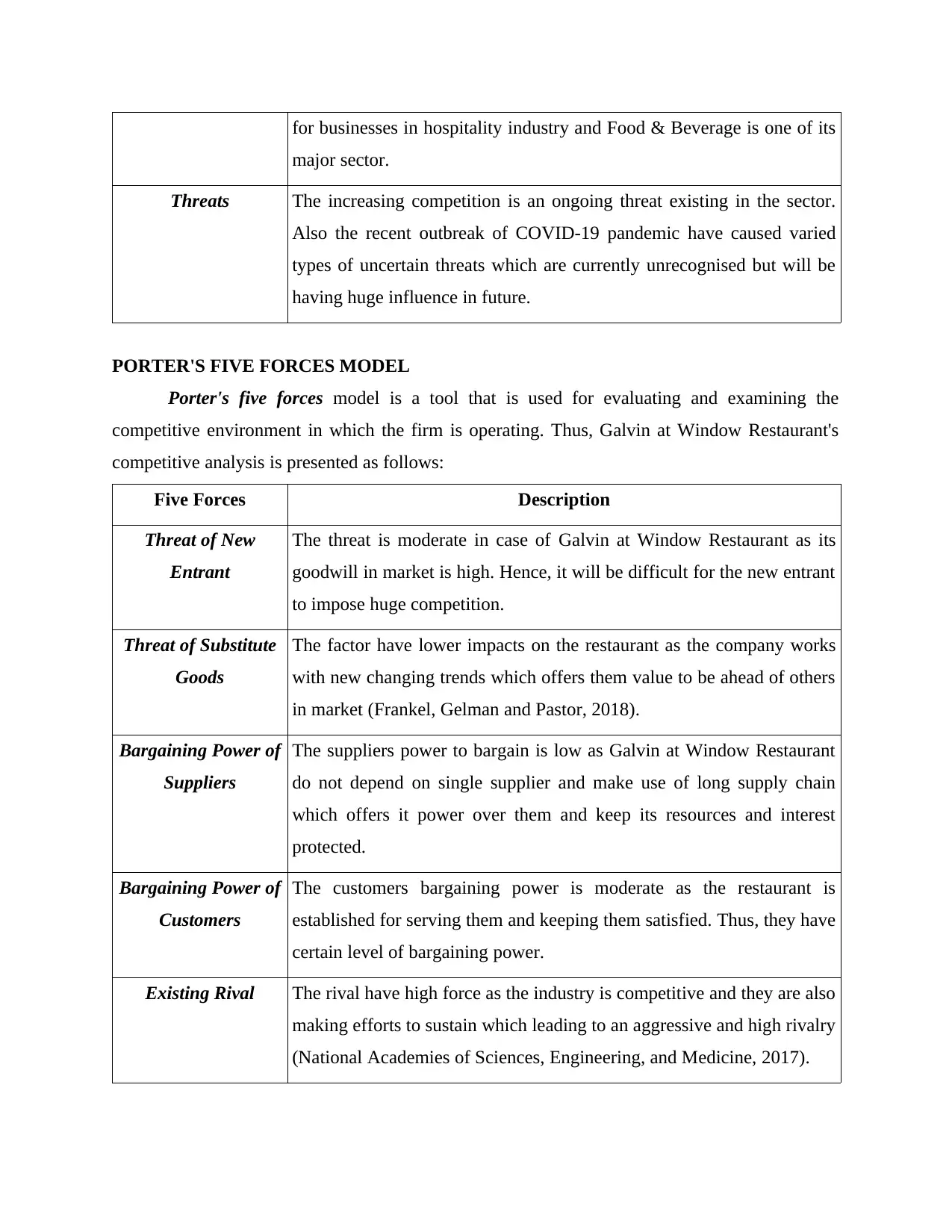
for businesses in hospitality industry and Food & Beverage is one of its
major sector.
Threats The increasing competition is an ongoing threat existing in the sector.
Also the recent outbreak of COVID-19 pandemic have caused varied
types of uncertain threats which are currently unrecognised but will be
having huge influence in future.
PORTER'S FIVE FORCES MODEL
Porter's five forces model is a tool that is used for evaluating and examining the
competitive environment in which the firm is operating. Thus, Galvin at Window Restaurant's
competitive analysis is presented as follows:
Five Forces Description
Threat of New
Entrant
The threat is moderate in case of Galvin at Window Restaurant as its
goodwill in market is high. Hence, it will be difficult for the new entrant
to impose huge competition.
Threat of Substitute
Goods
The factor have lower impacts on the restaurant as the company works
with new changing trends which offers them value to be ahead of others
in market (Frankel, Gelman and Pastor, 2018).
Bargaining Power of
Suppliers
The suppliers power to bargain is low as Galvin at Window Restaurant
do not depend on single supplier and make use of long supply chain
which offers it power over them and keep its resources and interest
protected.
Bargaining Power of
Customers
The customers bargaining power is moderate as the restaurant is
established for serving them and keeping them satisfied. Thus, they have
certain level of bargaining power.
Existing Rival The rival have high force as the industry is competitive and they are also
making efforts to sustain which leading to an aggressive and high rivalry
(National Academies of Sciences, Engineering, and Medicine, 2017).
major sector.
Threats The increasing competition is an ongoing threat existing in the sector.
Also the recent outbreak of COVID-19 pandemic have caused varied
types of uncertain threats which are currently unrecognised but will be
having huge influence in future.
PORTER'S FIVE FORCES MODEL
Porter's five forces model is a tool that is used for evaluating and examining the
competitive environment in which the firm is operating. Thus, Galvin at Window Restaurant's
competitive analysis is presented as follows:
Five Forces Description
Threat of New
Entrant
The threat is moderate in case of Galvin at Window Restaurant as its
goodwill in market is high. Hence, it will be difficult for the new entrant
to impose huge competition.
Threat of Substitute
Goods
The factor have lower impacts on the restaurant as the company works
with new changing trends which offers them value to be ahead of others
in market (Frankel, Gelman and Pastor, 2018).
Bargaining Power of
Suppliers
The suppliers power to bargain is low as Galvin at Window Restaurant
do not depend on single supplier and make use of long supply chain
which offers it power over them and keep its resources and interest
protected.
Bargaining Power of
Customers
The customers bargaining power is moderate as the restaurant is
established for serving them and keeping them satisfied. Thus, they have
certain level of bargaining power.
Existing Rival The rival have high force as the industry is competitive and they are also
making efforts to sustain which leading to an aggressive and high rivalry
(National Academies of Sciences, Engineering, and Medicine, 2017).
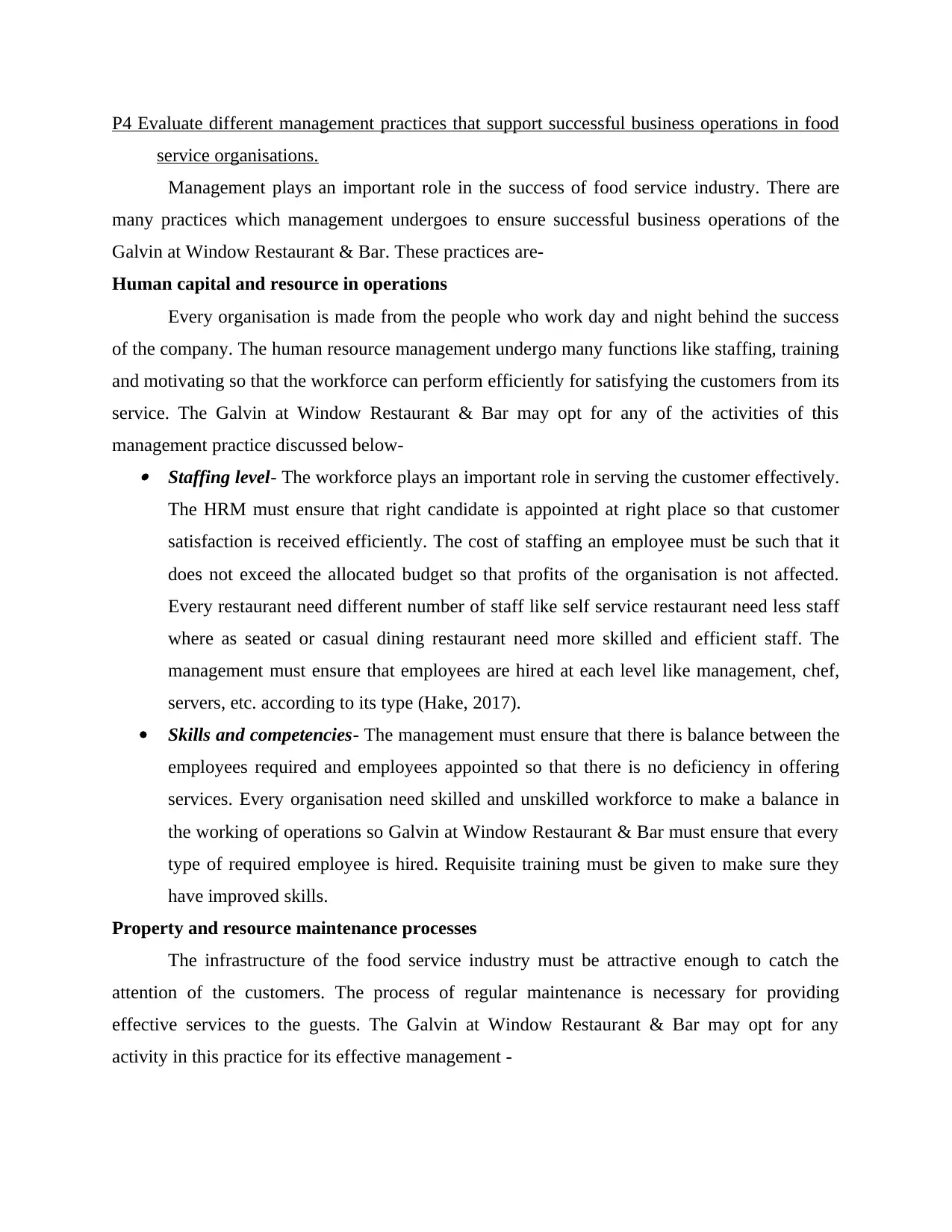
P4 Evaluate different management practices that support successful business operations in food
service organisations.
Management plays an important role in the success of food service industry. There are
many practices which management undergoes to ensure successful business operations of the
Galvin at Window Restaurant & Bar. These practices are-
Human capital and resource in operations
Every organisation is made from the people who work day and night behind the success
of the company. The human resource management undergo many functions like staffing, training
and motivating so that the workforce can perform efficiently for satisfying the customers from its
service. The Galvin at Window Restaurant & Bar may opt for any of the activities of this
management practice discussed below- Staffing level- The workforce plays an important role in serving the customer effectively.
The HRM must ensure that right candidate is appointed at right place so that customer
satisfaction is received efficiently. The cost of staffing an employee must be such that it
does not exceed the allocated budget so that profits of the organisation is not affected.
Every restaurant need different number of staff like self service restaurant need less staff
where as seated or casual dining restaurant need more skilled and efficient staff. The
management must ensure that employees are hired at each level like management, chef,
servers, etc. according to its type (Hake, 2017).
Skills and competencies- The management must ensure that there is balance between the
employees required and employees appointed so that there is no deficiency in offering
services. Every organisation need skilled and unskilled workforce to make a balance in
the working of operations so Galvin at Window Restaurant & Bar must ensure that every
type of required employee is hired. Requisite training must be given to make sure they
have improved skills.
Property and resource maintenance processes
The infrastructure of the food service industry must be attractive enough to catch the
attention of the customers. The process of regular maintenance is necessary for providing
effective services to the guests. The Galvin at Window Restaurant & Bar may opt for any
activity in this practice for its effective management -
service organisations.
Management plays an important role in the success of food service industry. There are
many practices which management undergoes to ensure successful business operations of the
Galvin at Window Restaurant & Bar. These practices are-
Human capital and resource in operations
Every organisation is made from the people who work day and night behind the success
of the company. The human resource management undergo many functions like staffing, training
and motivating so that the workforce can perform efficiently for satisfying the customers from its
service. The Galvin at Window Restaurant & Bar may opt for any of the activities of this
management practice discussed below- Staffing level- The workforce plays an important role in serving the customer effectively.
The HRM must ensure that right candidate is appointed at right place so that customer
satisfaction is received efficiently. The cost of staffing an employee must be such that it
does not exceed the allocated budget so that profits of the organisation is not affected.
Every restaurant need different number of staff like self service restaurant need less staff
where as seated or casual dining restaurant need more skilled and efficient staff. The
management must ensure that employees are hired at each level like management, chef,
servers, etc. according to its type (Hake, 2017).
Skills and competencies- The management must ensure that there is balance between the
employees required and employees appointed so that there is no deficiency in offering
services. Every organisation need skilled and unskilled workforce to make a balance in
the working of operations so Galvin at Window Restaurant & Bar must ensure that every
type of required employee is hired. Requisite training must be given to make sure they
have improved skills.
Property and resource maintenance processes
The infrastructure of the food service industry must be attractive enough to catch the
attention of the customers. The process of regular maintenance is necessary for providing
effective services to the guests. The Galvin at Window Restaurant & Bar may opt for any
activity in this practice for its effective management -
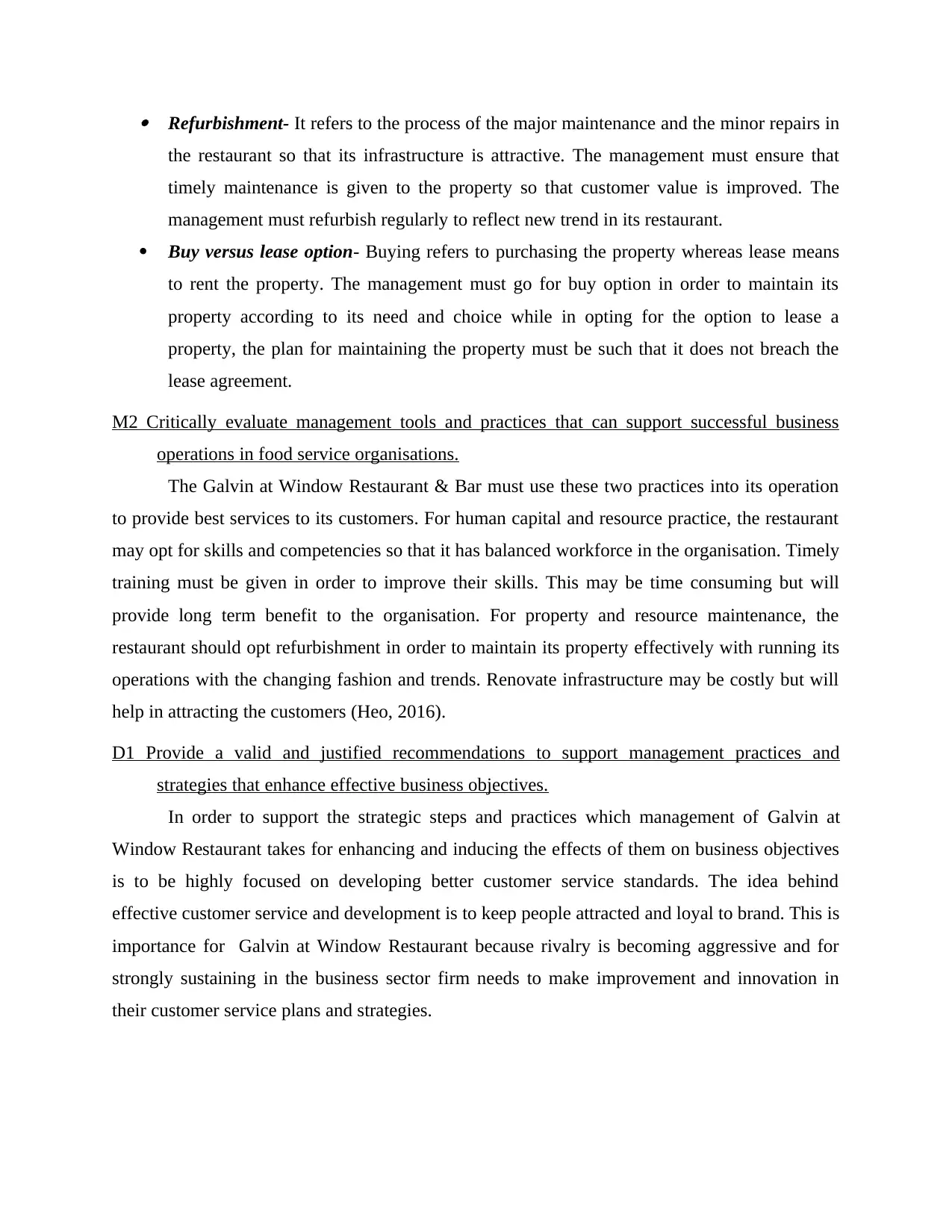
Refurbishment- It refers to the process of the major maintenance and the minor repairs in
the restaurant so that its infrastructure is attractive. The management must ensure that
timely maintenance is given to the property so that customer value is improved. The
management must refurbish regularly to reflect new trend in its restaurant.
Buy versus lease option- Buying refers to purchasing the property whereas lease means
to rent the property. The management must go for buy option in order to maintain its
property according to its need and choice while in opting for the option to lease a
property, the plan for maintaining the property must be such that it does not breach the
lease agreement.
M2 Critically evaluate management tools and practices that can support successful business
operations in food service organisations.
The Galvin at Window Restaurant & Bar must use these two practices into its operation
to provide best services to its customers. For human capital and resource practice, the restaurant
may opt for skills and competencies so that it has balanced workforce in the organisation. Timely
training must be given in order to improve their skills. This may be time consuming but will
provide long term benefit to the organisation. For property and resource maintenance, the
restaurant should opt refurbishment in order to maintain its property effectively with running its
operations with the changing fashion and trends. Renovate infrastructure may be costly but will
help in attracting the customers (Heo, 2016).
D1 Provide a valid and justified recommendations to support management practices and
strategies that enhance effective business objectives.
In order to support the strategic steps and practices which management of Galvin at
Window Restaurant takes for enhancing and inducing the effects of them on business objectives
is to be highly focused on developing better customer service standards. The idea behind
effective customer service and development is to keep people attracted and loyal to brand. This is
importance for Galvin at Window Restaurant because rivalry is becoming aggressive and for
strongly sustaining in the business sector firm needs to make improvement and innovation in
their customer service plans and strategies.
the restaurant so that its infrastructure is attractive. The management must ensure that
timely maintenance is given to the property so that customer value is improved. The
management must refurbish regularly to reflect new trend in its restaurant.
Buy versus lease option- Buying refers to purchasing the property whereas lease means
to rent the property. The management must go for buy option in order to maintain its
property according to its need and choice while in opting for the option to lease a
property, the plan for maintaining the property must be such that it does not breach the
lease agreement.
M2 Critically evaluate management tools and practices that can support successful business
operations in food service organisations.
The Galvin at Window Restaurant & Bar must use these two practices into its operation
to provide best services to its customers. For human capital and resource practice, the restaurant
may opt for skills and competencies so that it has balanced workforce in the organisation. Timely
training must be given in order to improve their skills. This may be time consuming but will
provide long term benefit to the organisation. For property and resource maintenance, the
restaurant should opt refurbishment in order to maintain its property effectively with running its
operations with the changing fashion and trends. Renovate infrastructure may be costly but will
help in attracting the customers (Heo, 2016).
D1 Provide a valid and justified recommendations to support management practices and
strategies that enhance effective business objectives.
In order to support the strategic steps and practices which management of Galvin at
Window Restaurant takes for enhancing and inducing the effects of them on business objectives
is to be highly focused on developing better customer service standards. The idea behind
effective customer service and development is to keep people attracted and loyal to brand. This is
importance for Galvin at Window Restaurant because rivalry is becoming aggressive and for
strongly sustaining in the business sector firm needs to make improvement and innovation in
their customer service plans and strategies.
Secure Best Marks with AI Grader
Need help grading? Try our AI Grader for instant feedback on your assignments.
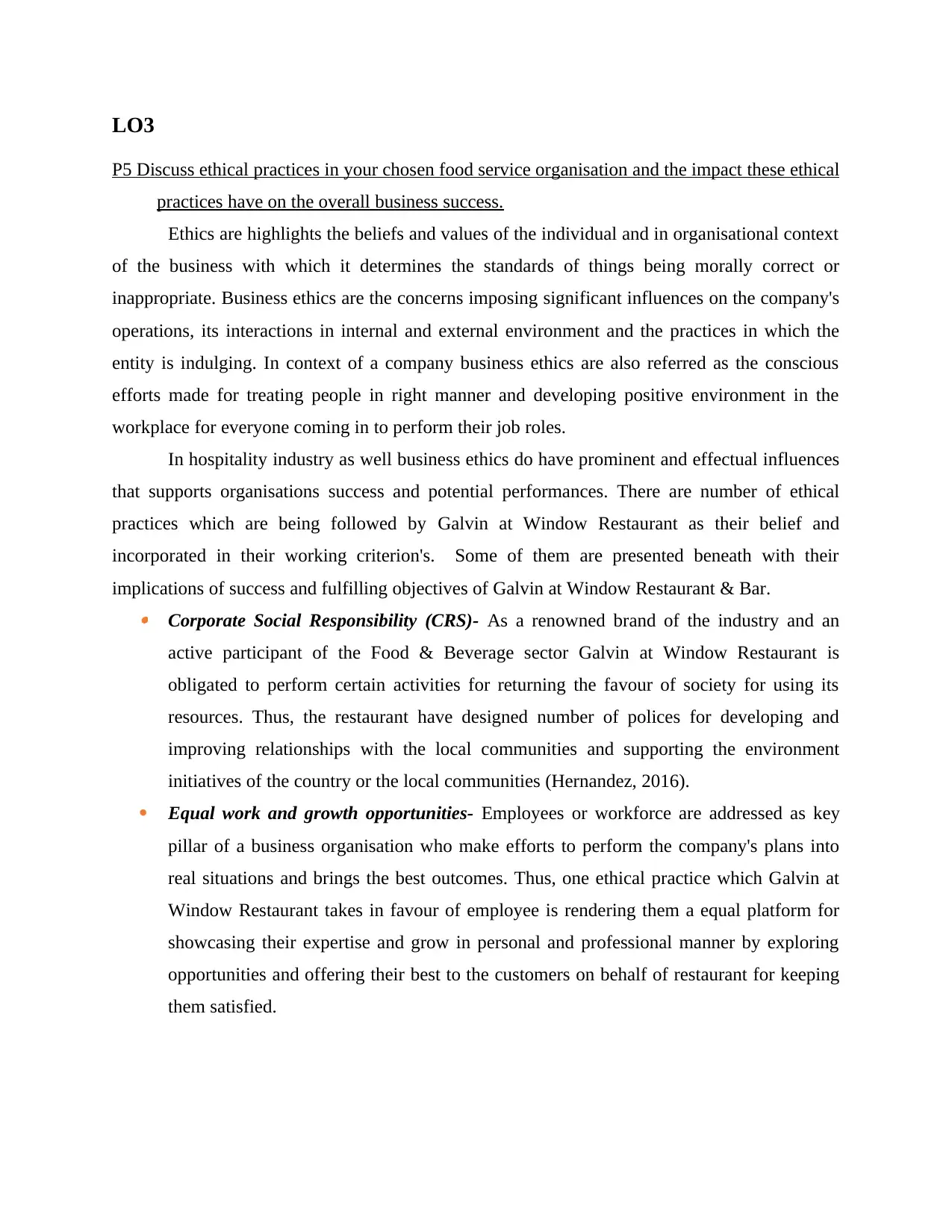
LO3
P5 Discuss ethical practices in your chosen food service organisation and the impact these ethical
practices have on the overall business success.
Ethics are highlights the beliefs and values of the individual and in organisational context
of the business with which it determines the standards of things being morally correct or
inappropriate. Business ethics are the concerns imposing significant influences on the company's
operations, its interactions in internal and external environment and the practices in which the
entity is indulging. In context of a company business ethics are also referred as the conscious
efforts made for treating people in right manner and developing positive environment in the
workplace for everyone coming in to perform their job roles.
In hospitality industry as well business ethics do have prominent and effectual influences
that supports organisations success and potential performances. There are number of ethical
practices which are being followed by Galvin at Window Restaurant as their belief and
incorporated in their working criterion's. Some of them are presented beneath with their
implications of success and fulfilling objectives of Galvin at Window Restaurant & Bar. Corporate Social Responsibility (CRS)- As a renowned brand of the industry and an
active participant of the Food & Beverage sector Galvin at Window Restaurant is
obligated to perform certain activities for returning the favour of society for using its
resources. Thus, the restaurant have designed number of polices for developing and
improving relationships with the local communities and supporting the environment
initiatives of the country or the local communities (Hernandez, 2016).
Equal work and growth opportunities- Employees or workforce are addressed as key
pillar of a business organisation who make efforts to perform the company's plans into
real situations and brings the best outcomes. Thus, one ethical practice which Galvin at
Window Restaurant takes in favour of employee is rendering them a equal platform for
showcasing their expertise and grow in personal and professional manner by exploring
opportunities and offering their best to the customers on behalf of restaurant for keeping
them satisfied.
P5 Discuss ethical practices in your chosen food service organisation and the impact these ethical
practices have on the overall business success.
Ethics are highlights the beliefs and values of the individual and in organisational context
of the business with which it determines the standards of things being morally correct or
inappropriate. Business ethics are the concerns imposing significant influences on the company's
operations, its interactions in internal and external environment and the practices in which the
entity is indulging. In context of a company business ethics are also referred as the conscious
efforts made for treating people in right manner and developing positive environment in the
workplace for everyone coming in to perform their job roles.
In hospitality industry as well business ethics do have prominent and effectual influences
that supports organisations success and potential performances. There are number of ethical
practices which are being followed by Galvin at Window Restaurant as their belief and
incorporated in their working criterion's. Some of them are presented beneath with their
implications of success and fulfilling objectives of Galvin at Window Restaurant & Bar. Corporate Social Responsibility (CRS)- As a renowned brand of the industry and an
active participant of the Food & Beverage sector Galvin at Window Restaurant is
obligated to perform certain activities for returning the favour of society for using its
resources. Thus, the restaurant have designed number of polices for developing and
improving relationships with the local communities and supporting the environment
initiatives of the country or the local communities (Hernandez, 2016).
Equal work and growth opportunities- Employees or workforce are addressed as key
pillar of a business organisation who make efforts to perform the company's plans into
real situations and brings the best outcomes. Thus, one ethical practice which Galvin at
Window Restaurant takes in favour of employee is rendering them a equal platform for
showcasing their expertise and grow in personal and professional manner by exploring
opportunities and offering their best to the customers on behalf of restaurant for keeping
them satisfied.
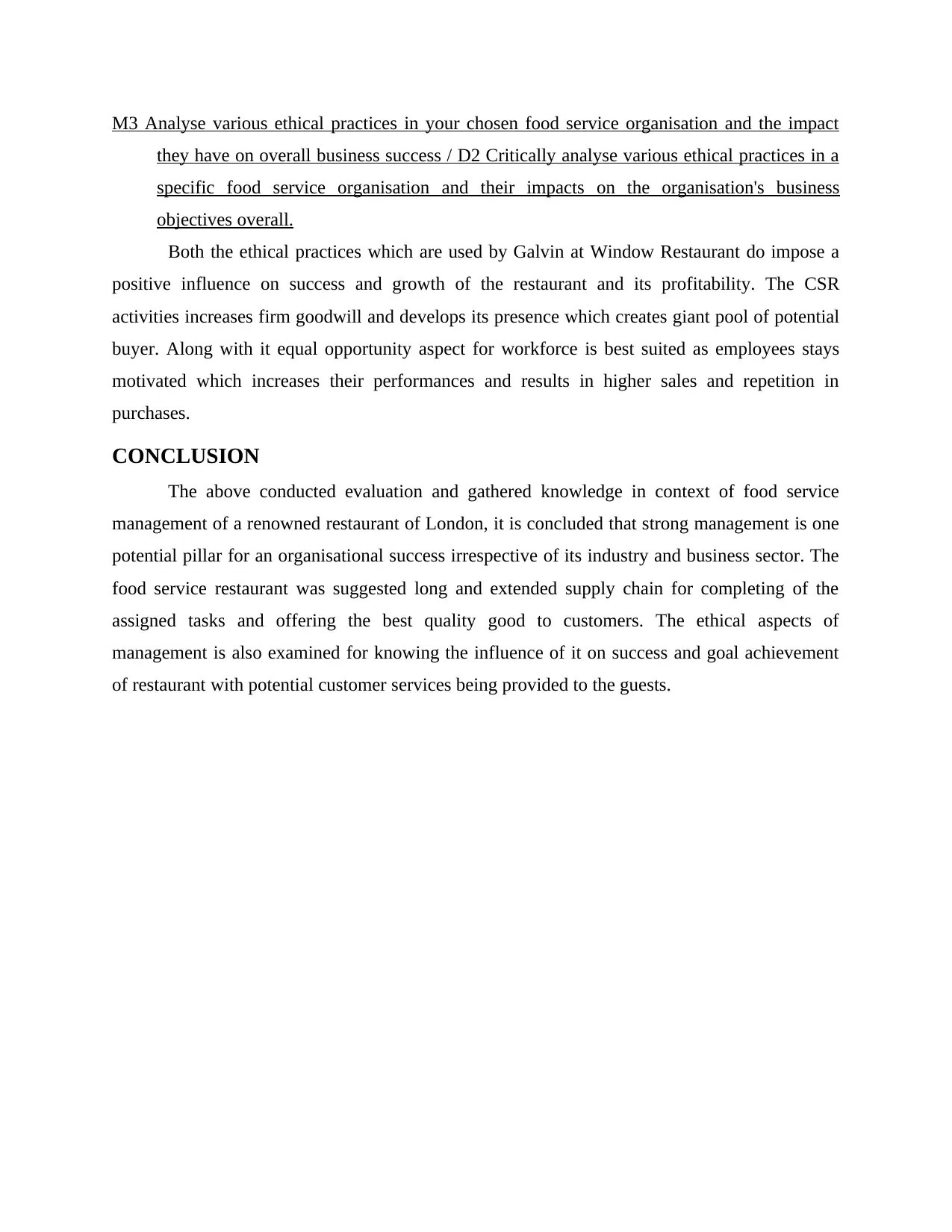
M3 Analyse various ethical practices in your chosen food service organisation and the impact
they have on overall business success / D2 Critically analyse various ethical practices in a
specific food service organisation and their impacts on the organisation's business
objectives overall.
Both the ethical practices which are used by Galvin at Window Restaurant do impose a
positive influence on success and growth of the restaurant and its profitability. The CSR
activities increases firm goodwill and develops its presence which creates giant pool of potential
buyer. Along with it equal opportunity aspect for workforce is best suited as employees stays
motivated which increases their performances and results in higher sales and repetition in
purchases.
CONCLUSION
The above conducted evaluation and gathered knowledge in context of food service
management of a renowned restaurant of London, it is concluded that strong management is one
potential pillar for an organisational success irrespective of its industry and business sector. The
food service restaurant was suggested long and extended supply chain for completing of the
assigned tasks and offering the best quality good to customers. The ethical aspects of
management is also examined for knowing the influence of it on success and goal achievement
of restaurant with potential customer services being provided to the guests.
they have on overall business success / D2 Critically analyse various ethical practices in a
specific food service organisation and their impacts on the organisation's business
objectives overall.
Both the ethical practices which are used by Galvin at Window Restaurant do impose a
positive influence on success and growth of the restaurant and its profitability. The CSR
activities increases firm goodwill and develops its presence which creates giant pool of potential
buyer. Along with it equal opportunity aspect for workforce is best suited as employees stays
motivated which increases their performances and results in higher sales and repetition in
purchases.
CONCLUSION
The above conducted evaluation and gathered knowledge in context of food service
management of a renowned restaurant of London, it is concluded that strong management is one
potential pillar for an organisational success irrespective of its industry and business sector. The
food service restaurant was suggested long and extended supply chain for completing of the
assigned tasks and offering the best quality good to customers. The ethical aspects of
management is also examined for knowing the influence of it on success and goal achievement
of restaurant with potential customer services being provided to the guests.

REFERENCES
Books and Journals
Bronson, K. and Knezevic, I., 2016. Big Data in food and agriculture. Big Data & Society, 3(1),
p.2053951716648174.
Brown, L. G. and et. al., 2018. Food safety practices linked with proper refrigerator temperatures
in retail delis. Foodborne pathogens and disease, 15(5), pp.300-307.
Chepchirchir, R. T. and et. al., 2017. Impact assessment of push-pull pest management on
incomes, productivity and poverty among smallholder households in Eastern
Uganda. Food security, 9(6), pp.1359-1372.
Coyle, A. and Fair, H., 2018. A human rights approach to prison management: Handbook for
prison staff. Institute for Criminal Policy Research Birkbeck, University of London.
Forsythe, S. J., 2020. The microbiology of safe food. John Wiley & Sons.
Frankel, A. J., Gelman, S. R. and Pastor, D. K., 2018. Case management: An introduction to
concepts and skills. Oxford University Press.
Hake, B. J., 2017. Gardens as learning spaces: Intergenerational learning in urban food
gardens. Journal of Intergenerational Relationships, 15(1), pp.26-38.
Heo, Y., 2016. Sharing economy and prospects in tourism research. Annals of tourism
Research, 58, pp.166-170.
Hernandez, D. C., 2016. Food Security. Encyclopedia of Family Studies, pp.1-8.
Homburg, C., Jozić, D. and Kuehnl, C., 2017. Customer experience management: toward
implementing an evolving marketing concept. Journal of the Academy of Marketing
Science, 45(3), pp.377-401.
Irani, Z. and Sharif, A. M., 2016. Sustainable food security futures. Journal of Enterprise
Information Management.
Ivanov, S. H., Webster, C. and Berezina, K., 2017. Adoption of robots and service automation by
tourism and hospitality companies. Revista Turismo & Desenvolvimento, 27(28),
pp.1501-1517.
Kirchhof, P. and et. al., 2016. A roadmap to improve the quality of atrial fibrillation
management: proceedings from the fifth Atrial Fibrillation Network/European Heart
Rhythm Association consensus conference. Ep Europace, 18(1), pp.37-50.
Kolesnikova, E. G. and Chekmeneva, T. D., 2016. Level of food self-sufficiency as criterion for
performing production function by rural territories of the Kemerovo region. Food
Processing: Techniques and Technology, 43(4), pp.164-172.
National Academies of Sciences, Engineering, and Medicine, 2017. Pain management and the
opioid epidemic: balancing societal and individual benefits and risks of prescription
opioid use. National Academies Press.
Online:
GALVIN at Windows Restaurant & Bar, 2020. [Online] Available Through:
<https://www.galvinatwindows.com//>
Books and Journals
Bronson, K. and Knezevic, I., 2016. Big Data in food and agriculture. Big Data & Society, 3(1),
p.2053951716648174.
Brown, L. G. and et. al., 2018. Food safety practices linked with proper refrigerator temperatures
in retail delis. Foodborne pathogens and disease, 15(5), pp.300-307.
Chepchirchir, R. T. and et. al., 2017. Impact assessment of push-pull pest management on
incomes, productivity and poverty among smallholder households in Eastern
Uganda. Food security, 9(6), pp.1359-1372.
Coyle, A. and Fair, H., 2018. A human rights approach to prison management: Handbook for
prison staff. Institute for Criminal Policy Research Birkbeck, University of London.
Forsythe, S. J., 2020. The microbiology of safe food. John Wiley & Sons.
Frankel, A. J., Gelman, S. R. and Pastor, D. K., 2018. Case management: An introduction to
concepts and skills. Oxford University Press.
Hake, B. J., 2017. Gardens as learning spaces: Intergenerational learning in urban food
gardens. Journal of Intergenerational Relationships, 15(1), pp.26-38.
Heo, Y., 2016. Sharing economy and prospects in tourism research. Annals of tourism
Research, 58, pp.166-170.
Hernandez, D. C., 2016. Food Security. Encyclopedia of Family Studies, pp.1-8.
Homburg, C., Jozić, D. and Kuehnl, C., 2017. Customer experience management: toward
implementing an evolving marketing concept. Journal of the Academy of Marketing
Science, 45(3), pp.377-401.
Irani, Z. and Sharif, A. M., 2016. Sustainable food security futures. Journal of Enterprise
Information Management.
Ivanov, S. H., Webster, C. and Berezina, K., 2017. Adoption of robots and service automation by
tourism and hospitality companies. Revista Turismo & Desenvolvimento, 27(28),
pp.1501-1517.
Kirchhof, P. and et. al., 2016. A roadmap to improve the quality of atrial fibrillation
management: proceedings from the fifth Atrial Fibrillation Network/European Heart
Rhythm Association consensus conference. Ep Europace, 18(1), pp.37-50.
Kolesnikova, E. G. and Chekmeneva, T. D., 2016. Level of food self-sufficiency as criterion for
performing production function by rural territories of the Kemerovo region. Food
Processing: Techniques and Technology, 43(4), pp.164-172.
National Academies of Sciences, Engineering, and Medicine, 2017. Pain management and the
opioid epidemic: balancing societal and individual benefits and risks of prescription
opioid use. National Academies Press.
Online:
GALVIN at Windows Restaurant & Bar, 2020. [Online] Available Through:
<https://www.galvinatwindows.com//>
1 out of 13
Related Documents
Your All-in-One AI-Powered Toolkit for Academic Success.
+13062052269
info@desklib.com
Available 24*7 on WhatsApp / Email
![[object Object]](/_next/static/media/star-bottom.7253800d.svg)
Unlock your academic potential
© 2024 | Zucol Services PVT LTD | All rights reserved.




